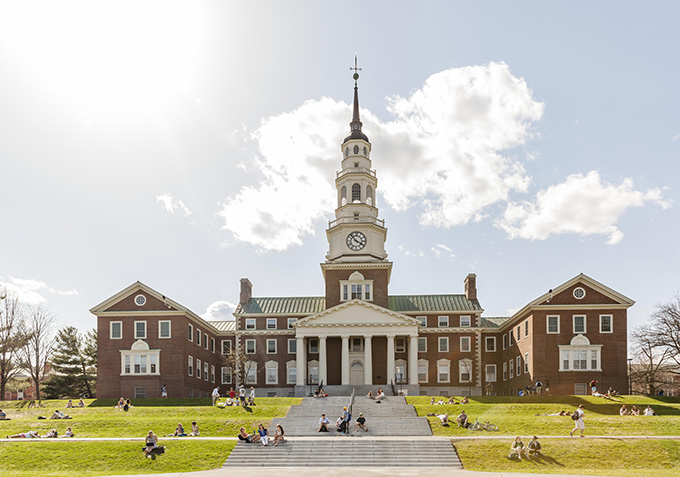Presidential Perspectives: David Greene, Colby College
April 15, 2019
Reading Time: 6 minutes

Over the last few years, Colby College has made a concerted effort to diversify its student body. From 2015 to 2018, Colby more than doubled the number of Pell-eligible students in the incoming class and has launched targeted financial aid programs to ensure that access to a Colby education includes low- and middle-income families. We sat down with President David A. Greene, who shared how Colby is making this transformation possible.
"The question for us was: How do you send a very clear message to families that a Colby education can be available to them? … The Colby Commitment and the Fair Shot Fund allow about 87 percent of families in the country—the vast majority—to consider Colby an option.”
– David A. Greene, Colby College.
Q: Why did you personally want to be involved in the American Talent Initiative?
A: The American Talent Initiative has brought together the country’s top universities and colleges all committed toward a common goal. Although, as a whole, higher education institutions are a collaborative and collegial network of organizations, we also compete with one another, so finding areas where we all have a shared interest in making substantial progress is critical. ATI has identified one of those areas, and it’s allowing us to leverage our shared efforts to do something that is of great importance to our institutions and the country.
Q: What were the biggest challenges facing Colby in reaching and enrolling more low- and moderate-income students?
A: Colby is not immune to the fundamental issues facing the nation’s top liberal arts colleges. One is that we’re seen as expensive, so affordability is critical. And for many lower- and moderate-income families, a focus on applied learning and access to the first job has become the calling card for a set of fields like engineering, for example, that are not the backbone of liberal arts colleges. Understanding the purpose and mission of a liberal arts college and the extraordinary opportunities provided by this type of education may be challenging for families who are unfamiliar with the liberal arts. I think those two things—affordability and communicating the mission and opportunities afforded at a liberal arts college—present a challenge in reaching families who may be lower-income or who may not have had experiences at places like Colby.
Q: A concern from ATI members and the public is that middle-income students could be squeezed out as institutions expand access for low-income students. Colby has two initiatives that specifically address affordability for both low- and middle-income students—one that provides zero family contribution for families who make less than $60,000 a year, and another that guarantees families who make less than $150,000 will pay no more than $15,000 annually.
Tell us about the thinking that went into the design of these incentives.
A: The question for us was: How do you send a very clear message to families that a Colby education can be available to them? Financial aid policies are often opaque, and it can be difficult to tell how decisions are made. And there’s no doubt that what we do is expensive. The kind of education we provide is faculty-intensive and requires extraordinary resources for undergraduate students. It’s a living learning community with an expansive infrastructure, and all these things are expensive to deliver. My goal is to always be disciplined on the expense side but to appreciate an extraordinary education is expensive to provide while focusing on the affordability issue. We had to send the signal to all families that our doors are open to their children if they are talented, driven, will make the most of a Colby education, and will contribute to the community. We want them here.
The first program we designed to show families they really can afford a Colby education is the Colby Commitment program, which, among other things, makes it possible for families with a household income of $60,000, the median in the U.S., or less to send their child to Colby with no parent or guardian contribution. And we package all financial aid with grants and no loans. This sends an important message to lower-income families, as loans can be a very significant impediment to college choice.
So through the Colby Commitment, about half of the parents in this country will not have to worry themselves about providing a contribution. The other program is called the Fair Shot Fund, which is intended to help middle-income families more broadly—families who feel squeezed out of higher education right now and might think they can’t send their children to schools like Colby. We again considered how to simplify the financial aid process so people would understand it clearly and see that Colby is within their reach. The program has a sliding scale from $60,000 to $150,000. At the top end of that, for those with a family income of $150,000, the expected annual contribution from parents or guardians will be no more than $15,000 a year. Colby’s comprehensive fee is currently about $70,000 a year, so that’s a very significant discount. This makes us less expensive to families than state universities, where the total fees average around $22,000 to $23,000 a year. If Colby is the right place for a student from a middle-income family, it will also be one of the most affordable colleges, and certainly one of the most affordable top colleges, in the country for them.
The Colby Commitment and the Fair Shot Fund allow about 87 percent of families in the country—the vast majority—to consider Colby an option.
Q: These are ambitious financial aid policies. What went into making them possible?
A: A combination of things made these programs possible—primarily philanthropy and institutional commitment.
The Fair Shot Fund came out of an incredible financial commitment following conversations I had with a Colby alumnus. His grandfather immigrated to the United States and worked in a quarry so he could send his children on to top colleges and universities. Then those children had extraordinary opportunities because of the education he provided, and their children have done well, too. We wanted to make sure that all families who are hard-working and trying to do their best in this country also have the opportunity for a great education. How do we keep the American Dream alive for these families?
Having a great gift to start off is important, but the second piece, which is equally important, is having an institutional commitment to getting this work done. That means allocating our own resources toward financial aid. There are many colleges and universities that can do these kinds of things if they make the commitment. It’s fundamentally about whether or not it’s a priority. We wanted to make sure that access and affordability would be a priority for Colby and that we would allocate our resources as well as raise money necessary. One way or another, we were going to get it done since we felt it was so essential to our mission, who we are as an institution, and what our broader place in the world is all about.
Q: It’s still early, but do you have a sense of the impact these policies are having on recruitment and enrollment of low- and moderate-income students?
A: It is early, but there are a few telling statistics. When I came to Colby in 2014, we had 5,000 applications for admission. This year we have 13,584 applications. The vast majority of those students would need significant financial aid to attend. We’ve been able to reach students we hadn’t been able to reach before—both geographically and demographically—which is important to us. The growth and diversity in our applicant pool along all different measures has increased significantly over that time.There are other indicators, too, like our Early Decision pool. Early decision typically attracts students from highly resourced families, but this year, more than 20 percent of the students accepted Early Decision were Pell-eligible.
I’d contrast this to a handful of years ago, when 9 percent of the entire student body at Colby was Pell-eligible. That’s climbing up very significantly. Last year 14 percent of the incoming class was Pell-eligible. Also, in the Early Decision cohort, we’re now at more than 30 percent students of color, which is a real high point for Colby. We’re seeing this demographic diversity shift in our pool because of the work we’re doing, and it’s been so encouraging. And on every measure we look at for academic quality, these students are the most prepared and qualified we’ve ever seen. I think for institutions that are committed to diversity and excellence—and the two things are completely intertwined in my view—having the right financial aid programs and the right messaging around them is a critical component of making that objective a reality.

Q: Part of ATI’s theory of change is that members can benefit from learning from each other about what works and what doesn’t. What lessons have you learned from creating these policies that might benefit your fellow ATI presidents—especially those at smaller private institutions like Colby?
A: I think for all of us, it’s about ensuring that access is an absolute institutional priority.
There are many different calls on the resources of our colleges and universities, and we make decisions every day about those. When we determine something is a high priority we always find a way to make it happen.
I think, for all of us, seeing this as a critical component of higher education is so essential. There are lots of creative ways that institutions can make progress. We’ve found ways that will work for us, others will find their own ways, but it all begins with setting it as an absolute top priority for institutions.
Q: What do you see as ATI’s potential impact on higher education more broadly?
A: ATI encourages the nation’s leading institutions to focus on access as a top priority. The second thing it will do is, by doing the first, it can actually help to change the opportunities we provide, the demographics of our institutions, and ultimately change leadership throughout this country. These are institutions that have long been educating leaders in various fields, and if we are to be able to do that in a way that focuses on diversity and access, we can give all people a chance no matter their background or financial means and allow them to have the very best opportunities in life. That to me is one of the most fundamental things that higher education can do, and ATI is helping to push us all in that direction in a way that will have a major impact not just on our institutions but on the country as a whole.


